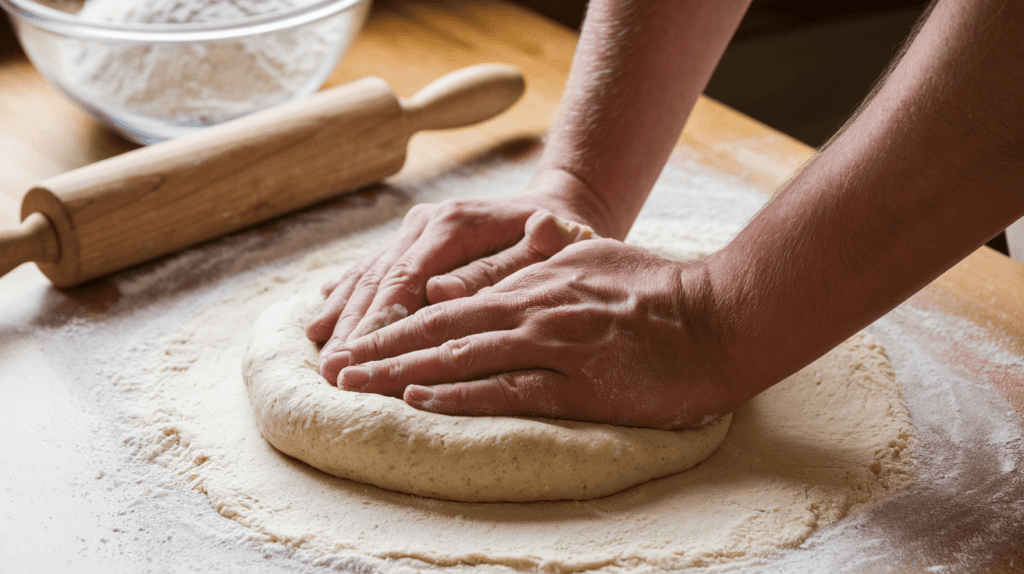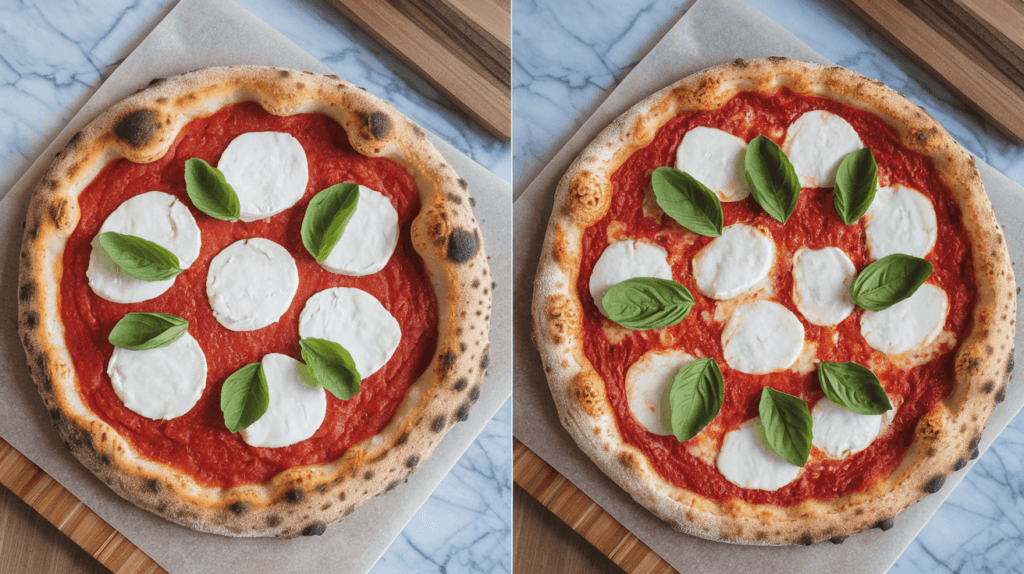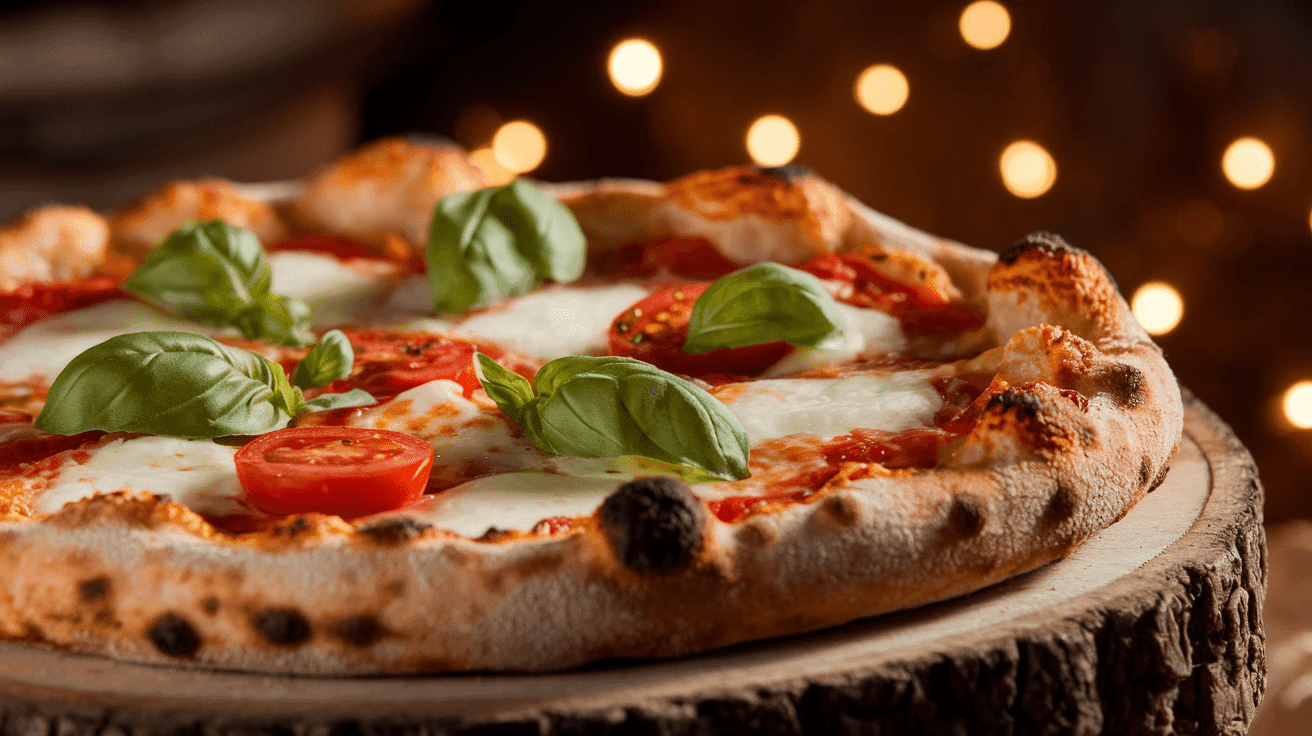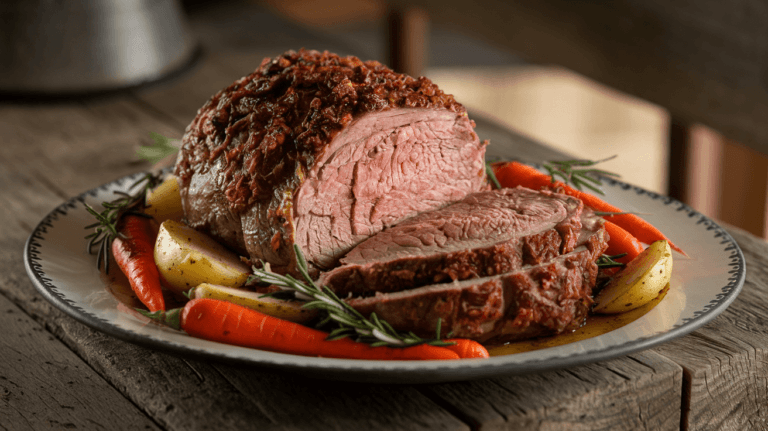Pizza is a beloved comfort food, but for those avoiding gluten, finding a delicious alternative can be tricky. Whether you’re following a Gluten free pizza diet due to celiac disease, gluten sensitivity, or personal preference, there’s no need to give up on pizza night!
Table of Contents
What is Gluten-Free Pizza?
Gluten-free pizza is a type of pizza made without wheat, barley, or rye grains that contain gluten. Instead, it uses alternative flours like rice, almond, coconut, or chickpea flour to create a crust that mimics traditional pizza dough. The goal is to replicate the chewy, crispy texture of regular pizza while ensuring it’s safe for those with gluten sensitivities.
Why Choose a Gluten-Free Diet?
Many people opt for a gluten-free diet for medical or lifestyle reasons. The most common reasons include:
- Celiac Disease – An autoimmune condition where consuming gluten triggers severe digestive issues and damages the small intestine.
- Gluten Sensitivity – While not as severe as celiac disease, some people experience bloating, headaches, or joint pain after eating gluten.
- Wheat Allergy – A rare but serious condition where wheat proteins cause an allergic reaction.
- Health & Wellness – Some believe that reducing gluten can improve digestion, reduce inflammation, or boost energy levels.
How Gluten-Free Pizza Differs from Traditional Pizza
Unlike regular pizza, gluten-free pizza crust tends to be denser, crispier, and sometimes a bit more fragile due to the absence of gluten. However, when made correctly, it can be just as delicious—if not better—than traditional pizza! Some key differences include:
✅ Flour Substitutes – Instead of wheat flour, gluten-free pizza uses flours made from rice, quinoa, almond, or chickpeas.
✅ Binding Agents – Since gluten gives dough elasticity, ingredients like xanthan gum or psyllium husk are used to hold the dough together.
✅ Texture & Taste – Depending on the flour blend, gluten-free crusts can be light and crispy or thick and chewy.
Ingredients in Gluten-Free Pizza Dough
Alternative Flours: Rice, Almond, Coconut, and More
The foundation of gluten-free pizza starts with the right flour blend. Since traditional wheat flour contains gluten, gluten-free alternatives rely on a mix of flours to achieve the right taste and texture. Some of the best options include:
- Rice Flour – A light, neutral-tasting flour that forms the base of many gluten-free pizza crusts.
- Almond Flour – Adds a nutty flavor and richness while keeping the crust low in carbs.
- Coconut Flour – Absorbs moisture well and provides a slightly sweet undertone.
- Chickpea Flour – High in protein and fiber, this flour gives the crust a hearty, earthy taste.
- Tapioca & Potato Starch – Often used to improve elasticity and give the dough a slight chewiness.
Binding Agents: Xanthan Gum, Psyllium Husk, and Others
Since gluten gives dough its stretchy, elastic quality, gluten-free pizza dough needs a substitute to hold it together. That’s where binding agents come in:
- Xanthan Gum – The most common ingredient used in gluten-free baking. It helps mimic gluten’s elasticity.
- Psyllium Husk – Absorbs water and creates a soft, chewy texture.
- Ground Flaxseeds or Chia Seeds – Act as a natural binder and add fiber.
Nutritional Value of Gluten-Free Pizza Compared to Regular Pizza
Many assume that gluten-free pizza is automatically healthier, but that depends on the ingredients used. While gluten-free crusts can be more nutrient-dense—especially if made with almond or chickpea flour—they can also be higher in carbs if made with rice flour.
✅ Lower in gluten, great for digestion
✅ Higher in fiber (if using whole-grain or nut-based flours)
❌ Can be higher in calories due to added starches and binding agents
How to Make Gluten-Free Pizza at Home

Step-by-Step Guide to Making the Perfect Dough
Making gluten-free pizza at home is easier than you think! Follow these simple steps:
- Mix the Dry Ingredients – Combine 2 cups of gluten-free flour blend, 1 tsp of xanthan gum (if not already in the flour), 1 tsp of salt, and 1 tsp of baking powder.
- Activate the Yeast – In a separate bowl, mix ¾ cup of warm water, 1 tsp of sugar, and 2 tsp of active dry yeast. Let it sit for 5-10 minutes until foamy.
- Combine Wet and Dry Ingredients – Slowly add the yeast mixture to the dry ingredients along with 2 tbsp of olive oil. Mix until a dough forms.
- Knead and Rest – Knead for 5 minutes, then let it rise in a warm place for 30-45 minutes.
- Roll Out the Dough – Place the dough between two sheets of parchment paper and roll it out to your desired thickness.
- Pre-Bake the Crust – Bake at 400°F (200°C) for 10 minutes before adding toppings.
- Add Toppings & Bake Again – Top with your favorite ingredients and bake for another 10-15 minutes until golden and crispy.
Tips for Achieving the Right Texture and Flavor
- Use a pizza stone – It helps create a crispy bottom crust.
- Brush with olive oil – This prevents dryness and enhances flavor.
- Don’t skip pre-baking – It ensures the crust isn’t soggy.
- Let the dough rest – This allows flavors to develop and improves texture.
Best Toppings for Gluten-Free Pizzas
When it comes to toppings, the sky’s the limit! Here are some delicious combinations:
🍅 Classic Margherita – Tomato sauce, fresh mozzarella, and basil.
🍕 Mediterranean Style – Feta cheese, olives, red onions, and spinach.
🌶 Spicy BBQ Chicken – Grilled chicken, BBQ sauce, red onions, and jalapeños.
🥑 Vegan Delight – Cashew cheese, mushrooms, bell peppers, and avocado.
Homemade gluten-free pizza lets you customize flavors while ensuring it’s safe and healthy. Plus, nothing beats the satisfaction of making your own!
The Best Gluten-Free Pizza Chains & Restaurants
Finding a restaurant that serves gluten-free pizza can be a challenge, especially if you’re worried about cross-contamination. Thankfully, many pizzerias now offer dedicated gluten-free options that taste just as good as their traditional counterparts.
Top 10 Gluten-Free Pizzerias in the U.S.
If you’re craving a slice, here are some of the best places to get a delicious gluten-free pizza:
- Razzi’s Pizzeria (Seattle, WA) – Offers multiple gluten-free crust options and a full gluten-free menu.
- Spinato’s Pizzeria (Arizona) – Uses a rice flour-based crust that’s light and crispy.
- Via 313 Pizza (Multiple Locations) – Specializes in Detroit-style gluten-free pizza with tons of toppings.
- El Diablo Brewing Co. (Greensburg, PA) – Features a gluten-free pizza skillet option.
- Emmy Squared (Multiple Locations) – Serves thick, bready Detroit-style gluten-free pizza crust.
- Blue Pan Pizza (Colorado) – Makes award-winning gluten-free Detroit-style pies.
- Robert’s Pizza & Dough Co. (Chicago, IL) – Uses a special blend for a crispy, flavorful crust.
- Bellagreen (Texas) – Offers multiple wood-fired gluten-free pizza options.
- Rubirosa (New York City, NY) – Features a full gluten-free menu with pizzas, pastas, and more.
- Chicago’s Pizza (Chicago, IL) – Known for its deep-dish gluten-free pizza.
How to Identify Safe Restaurants for Celiac Disease
Not all restaurants take the same precautions when making gluten-free pizza. To ensure a safe dining experience:
- Ask about cross-contamination – Does the restaurant use a separate oven or prep area?
- Look for certification – Some pizzerias are certified gluten-free by organizations like Beyond Celiac.
- Read reviews – Other gluten-free diners can offer insights into how safe the place really is.
Cross-Contamination Risks and How Restaurants Handle Them
Even if a pizzeria offers gluten-free pizza crust, it might not be entirely safe for those with celiac disease. Here are some ways restaurants prevent cross-contamination:
✅ Dedicated prep areas – Ensures gluten-free ingredients don’t mix with regular ones.
✅ Separate utensils – Pizza cutters, pans, and gloves should be exclusive to gluten-free pizzas.
✅ Staff training – Employees should be aware of how to handle gluten-free orders properly.
Buying Gluten-Free Pizza: Store-Bought vs. Homemade

Sometimes, making gluten-free pizza from scratch isn’t an option. That’s where store-bought alternatives come in handy! But are they as good as homemade? Let’s compare the two.
Best Gluten-Free Pizza Brands Available in Stores
For those who need a quick and easy option, here are some of the best store-bought gluten-free pizza brands:
- Caulipower – Uses a cauliflower-based crust that’s both crispy and flavorful.
- Against the Grain – Made with a blend of tapioca starch and cheese for a chewy texture.
- Udi’s Gluten-Free – One of the most widely available brands, known for its thin and crispy crust.
- Daiya – A dairy-free and gluten-free pizza option, great for vegans.
- Freschetta Gluten-Free – Features a classic-style crust that’s soft yet sturdy.
These pre-made pizzas are convenient, but they don’t always match the flavor and freshness of homemade gluten-free pizza.
Pros and Cons of Store-Bought vs. Homemade Options
Store-Bought Gluten-Free Pizza
✅ Quick and easy
✅ No need to prepare ingredients
✅ Great for busy nights
❌ May contain preservatives
❌ Often more expensive
❌ Limited customization options
Homemade Gluten-Free Pizza
✅ Fresh ingredients and full control over flavors
✅ Can be made healthier with whole-food ingredients
✅ No risk of hidden gluten
❌ Takes more time and effort
❌ Requires specialty ingredients like xanthan gum
How to Spot the Best Pre-Made Gluten-Free Pizza
When buying a gluten-free pizza from the store, check the ingredients list. Avoid products with too many additives, and look for those made with quality alternative flours like almond or chickpea flour. Also, opt for brands that have good reviews and certifications for being truly gluten-free.
Common Myths About Gluten-Free Pizza
There are plenty of misconceptions surrounding gluten-free pizza, from its taste to its health benefits. Let’s bust some of the biggest myths!
Does Gluten-Free Pizza Taste Bad?
One of the most common myths is that gluten-free pizza tastes bland or has a strange texture. While early versions may have been dry and crumbly, today’s gluten-free crusts are much better!
✅ High-quality alternative flours like almond and chickpea flour add richness and flavor.
✅ Modern recipes use binding agents like xanthan gum to create a chewy, crispy texture.
✅ Many gluten-free pizzerias have perfected their crusts to rival traditional pizza.
If you’ve had a bad experience with gluten-free pizza, it was probably due to the wrong flour blend or a poor cooking method. Give it another shot—there are amazing options out there!
Is Gluten-Free Pizza Always Healthier?
Just because a pizza is gluten-free doesn’t automatically make it healthier. While some gluten-free crusts use nutrient-dense ingredients, others rely on starchy fillers that can be just as high in calories and carbs as regular pizza.
- Healthier Gluten-Free Pizzas – Made with almond, chickpea, or cauliflower flour, offering more fiber and protein.
- Less Healthy Options – Some store-bought gluten-free pizzas contain refined starches and preservatives.
To make a truly healthy gluten-free pizza, focus on whole-food ingredients and avoid overly processed options.
Is It Safe for People Without Gluten Sensitivities?
Absolutely! Anyone can enjoy gluten-free pizza—not just those with celiac disease or gluten intolerance. Many people choose it for its unique flavors, lighter texture, or alternative ingredients. If made well, you won’t even miss traditional pizza crust!
FAQs
Many people have questions about gluten-free pizza, so let’s tackle some of the most common ones!
What is gluten-free pizza crust made of?
Gluten-free pizza crust is typically made from alternative flours like rice, almond, or chickpea flour. To hold it together, ingredients like xanthan gum, psyllium husk, or eggs are used. Some brands also use cauliflower or sweet potatoes as a base for a lower-carb option.
Is gluten-free pizza healthier than regular pizza?
It depends on the ingredients. If made with whole-food flours, gluten-free pizza can be higher in fiber and protein than regular pizza. However, some store-bought versions contain refined starches and added sugars, making them less healthy.
How do you make gluten-free pizza dough rise better?
Since gluten-free dough lacks elasticity, you can improve its rise by:
- Adding baking powder or yeast for extra lift.
- Using warm water and sugar to activate the yeast.
- Letting the dough rest for at least 30 minutes before baking.
Can you buy good frozen gluten-free pizza?
Yes! Some of the best frozen gluten-free pizza brands include Caulipower, Against the Grain, and Udi’s. These options provide great flavor and texture, making them a convenient alternative to homemade pizza.
Conclusion – Is Gluten-Free Pizza Worth It?
So, is gluten-free pizza worth the hype? Absolutely! Whether you have celiac disease, a gluten sensitivity, or just want to try something different, there are plenty of delicious options available. From homemade recipes to store-bought brands and restaurant-quality pies, gluten-free pizza has come a long way.
✅ Better ingredient options – Alternative flours like almond and chickpea provide great texture and flavor.
✅ More availability – Many restaurants and stores now offer high-quality gluten-free pizza.
✅ Healthier choices – When made with whole-food ingredients, it can be a nutritious alternative to traditional pizza.
That being said, not all gluten-free pizzas are created equal. Some contain processed starches, while others may not be completely safe for those with celiac disease due to cross-contamination risks. The key is to choose wisely—whether making it at home or ordering from a restaurant.
If you haven’t tried gluten-free pizza yet, now’s the perfect time! Experiment with different crusts, toppings, and brands to find what works best for you. Who knows? You might just find a new favorite way to enjoy pizza night! 🍕
Bonus Tips & Resources for Gluten-Free Pizza Lovers
Before you go, here are some extra tips and resources to make your gluten-free pizza experience even better!
Pro Tips for the Best Gluten-Free Pizza
- Use a pizza stone – It helps achieve a crispy crust.
- Let the dough rest – Resting allows the flours to absorb moisture, improving texture.
- Brush with olive oil – Adds flavor and prevents dryness.
- Pre-bake the crust – This keeps it from getting soggy once you add toppings.
- Experiment with flours – Try almond, chickpea, or cauliflower flour to find your perfect crust.
Best Resources for Gluten-Free Pizza
📌 Beyond Celiac – Great for learning about celiac-safe options.
📌 Gluten-Free Living Magazine – Covers recipes, restaurant guides, and expert advice.
📌 Online Communities – Facebook groups and Reddit forums offer real-life reviews and recommendations.
If you’re looking for more tasty recipes, check out our collection of delicious meal ideas!




